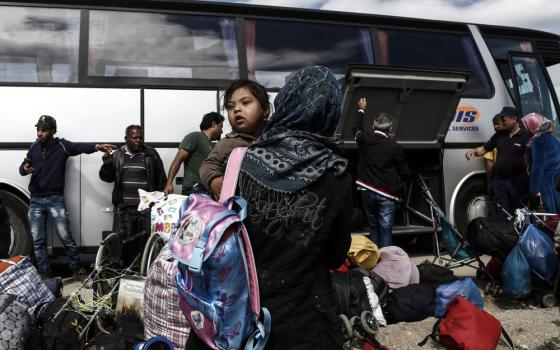History's judgment can be harsh. So how will future generations look back on us and what we did — or, more to the point, didn't do — for the millions of refugees from Syria?
That's the question Nicholas Kristof asks in a poignant column in The New York Times showing how today's rejection of Syrians fleeing slaughter mirrors the world's rejection of Jewish refugees before the Holocaust.
And just to drive the point home to the millions of people who have read Anne Frank's The Diary of a Young Girl, Kristof shows how Anne's father, Otto, desperately tried to get his family to America but was unable to get a visa, despite pulling strings within the Roosevelt administration.
President Barack Obama has said the United States would accept 10,000 Syrian refugees, a thimbleful against the tide. As Kristof says, "History rhymes."
How long before we look back on these years and ask, "Why didn't we do more?" How long before our children ask us, "How could you stand by and do nothing?"
As Kristof puts it: "Today, to our shame, Anne Frank is a Syrian girl."
Want to help disaster victims? Do so thoughtfully
In any natural disaster, the immediate reaction is to want to help in some way. And that is a great thing — it is usually the worst of circumstances that often bring out the very best in people.
But well-thought-out help is much better than knee-jerk-reaction help, which can sometimes do more harm than good.
Religion News Service recently had advice for those wanting to help victims of the devastating flooding in Louisiana: Don't just jump in your car and drive down. At least not yet.
"Being a spontaneous unaffiliated volunteer ... is likely to cause more harm than good," the column noted. "Sending supplies before communities are ready to receive them isn't the way to help either. You will likely only add to the chaos happening there."
Instead, work with established groups that know what they're doing and how to do it. They also have the resources to provide for their volunteers, so they're not taxing an already-broken infrastructure.
"Look for ways to help through established relief groups, ministries, community organizations and the like. ... If you want to do something now, that's good, but realize that some people are better-prepared to act now because they prepared last year. So, partner with them," the column advised.
"Fill the truck" campaigns and other efforts are also wonderful — if the truck is filled with what victims actually need. Listen to those who know what the actual needs are.
"Don't assume you know what survivors need," the column said. "If your help is going to make a positive difference, it needs to match up with what the actual needs on the ground are right now, and with what those needs will be later."
So what can you do? You can pray, and you can give financially. And then, when it is clear what is needed, you can respond with your time and talents.
As the column points out, "A desire to help is good; doing things that actually help is better."
The real deal with the U.S.-Mexico border
Al Jazeera's AJ+ has a video examining "The Real Deal with the U.S.-Mexico Border," a concise but in-depth look at what's happening on America's most controversial fence line.
It notes that while 93 percent of the cocaine consumed in the United States comes across the U.S.-Mexico border, every year, an average of 253,000 guns bought in the United States cross the border into Mexico.
In the meantime, the U.S. budget for Customs and Border Protection has increased 75 percent in the last decade to $13.5 billion a year. Add in the budget for Immigration and Customs Enforcement, and the total is more than we spend on the Drug Enforcement Administration, the FBI and the Secret Service combined.
All of this means more danger for border-crossers, more deaths, and a market for human smuggling.
Remember, links, tips and accounts of the response to any crisis anywhere in the world are always welcome at dstockman@ncronline.org.
[Dan Stockman is national correspondent for Global Sisters Report. Follow him on Twitter or on Facebook.]

